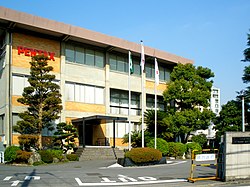Pentax

Pentax head office in Itabashi-ku, Tokyo
|
|
| Public : (–2007); Subsidiary of Hoya Corporation (2007–2008) | |
| Industry | Imaging |
| Fate | Merged into Hoya Corporation & IBM Corporation (Currently health care division of Hoya & IBM); imaging division resold to Ricoh |
| Successor | Pentax Ricoh Imaging Company Ltd. |
| Founded | November 1919 Tokyo, Japan |
| Defunct | March 31, 2008 |
| Headquarters | Tokyo, Japan |
|
Area served
|
Worldwide |
|
Key people
|
Fumio Urano, President & CEO; Ganesh Ramaswamy, Global President, Pentax Medical, Hoya Corporation |
| Products | Cameras and photographic equipment; binoculars, spotting scopes and telescopes; medical fiberscopes and endoscopes; medical fine ceramics products; information and communications products; components; industrial products; eyeglass lenses |
| Revenue |
|
|
|
|
|
Number of employees
|
1,661 (as of March 31, 2005; non-consolidated Pentax Corp. only) |
| Website | Pentax English site |
![]() 3.57 billion yen
3.57 billion yen
Pentax (ペンタックス) is a brand name used primarily by Ricoh Imaging Company for cameras, sport optics (including binoculars and rifle scopes), and CCTV optics. The brand is also used by Hoya Corporation for medical products & services, TI Asahi for surveying instruments, and Seiko Optical Products for certain optical lenses.
The company was founded as Asahi Kogaku Goshi Kaisha in November 1919 by Kumao Kajiwara, at a shop in the Toshima suburb of Tokyo, and began producing spectacle lenses (which it still manufactures). In 1938 it changed its name to Asahi Optical Co., Ltd. (旭光学工業株式会社 Asahi Kōgaku Kōgyō Kabushiki-gaisha?), and by this time it was also manufacturing camera/cine lenses. In the lead-up to World War II, Asahi Optical devoted much of its time to fulfilling military contracts for optical instruments. At the end of the war Asahi Optical was disbanded by the occupying powers, being allowed to re-form in 1948. The company resumed its pre-war activities, manufacturing binoculars and consumer camera lenses for Konishiroku and Chiyoda Kōgaku Seikō (later Konica and Minolta respectively).
The period around 1950 marked the return of the Japanese photographic industry to the vigorous level of the late 1930s, and its emergence as a major exporter. The newly reborn industry had sold many of its cameras to the occupation forces (having had far more disposable income than the Japanese) and they were well received. The Korean War saw a huge influx of journalists and photographers to the Far East, where they were impressed by lenses from companies such as Nikon and Canon for their Leica rangefinder cameras, and also by bodies by these and other companies to supplement and replace the Leica and Contax cameras they were using.
...
Wikipedia
